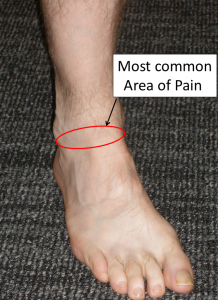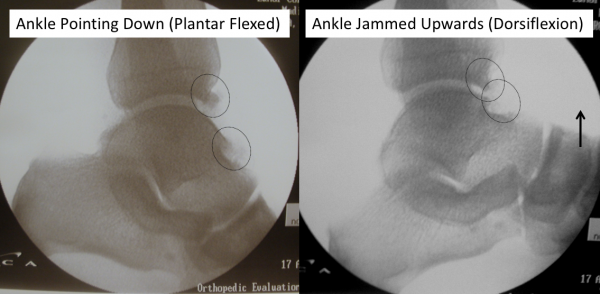Anterior Ankle Impingement
Background and Clinical Presentation
Anterior ankle impingement is one of the most common cause of pain in the front of the ankle joint (Figure 1). Impingement describes the pinching of bone spurs or soft-tissue scar at the front (anterior portion) of the ankle joint. This pinching is aggravated by walking or leaning forward (dorsiflexion of the ankle). Often this impingement is due to the development of bone spurs that are also known as osteophytes. These bone spurs form at the front of the ankle joint on the upper bone of the ankle (tibia) and/or the lower bone of the ankle (talus). Sometimes inflamed soft tissue as opposed to bone spurs can cause anterior ankle impingement. Ankle bone spur formation may result from frequent forceful bending of the ankle upwards (dorsiflexion) or leaning over the ankle with the heel on the ground. Soccer or dancing are activities that can cause bone spurs, as can frequent ankle sprains. Bone spurs may also form as a result of early ankle arthritis.
Signs and Symptoms associated with Anterior Ankle Impingement
Squatting, bending, and going upstairs or inclines causes pinching of the bone spurs at the front of the ankle often leading to anterior ankle pain.


Imaging Studies in Anterior Ankle Impingement
Bone spurs at the front of the ankle can be seen on an ankle x-ray taken from the side (lateral view). They typically appear as a bony “beak” extending from the front of the ankle joint. These spurs serve to physically block upward ankle motion (Figure 2). The size of the bone spur can vary from very small to quite large (Figure 3). X-rays may also demonstrate mild, moderate, or even severe ankle arthritis.

In early anterior ankle impingement, an MRI may demonstrate inflammation or fluid accumulation in the front of the ankle joint. An MRI may also identify soft-tissue scarring that can cause anterior ankle impingement.
Non-Operative Anterior Ankle Impingement Treatment
Early on, anterior ankle impingement treatment focuses on stretching, physical therapy, over-the-counter medications, shoe inserts, and injections. Some potentially effective non-operative treatments for anterior ankle impingement are:
- Use of a Slightly Elevated Heel: Using a shoe with 1-1.5” heel (or adding a heel lift inside the shoe) means that the foot does not need to come up as far in the course of normal walking. Therefore, less impingement occurs and patients will tend to be less symptomatic.
- Activity Modification: If appropriate, avoiding or limiting activities (i.e. certain sporting activities or walking uphill) that cause ankle jamming will tend to cause the symptoms to improve.
- Anti-inflammatory medication (NSAIDs): The use of anti-inflammatory medication (assuming no contra-indications) can be helpful if persistent symptoms are present.
- An occasional injection of corticosteroid into the ankle joint may be helpful, particularly if there is some underlying ankle arthritis present.
- If frequent sprains from ankle instability are a source of bone spur formation, exercises to stabilize the ankle and avoid sprains can be useful.
Operative Anterior Ankle Impingement Treatment
The focus of operative treatment is to remove the impinging bone spurs or inflamed soft tissue at the front of the ankle and increase ankle motion. The goal of this surgery is to decrease the pressure created in the front of the joint during walking or other activities. This can be done arthroscopically, through a camera with small instruments inserted into the joint, or with a open slightly larger incision to remove the bone spurs. Bone spur removal is sometimes coupled with procedures to stabilize stretched out lateral ankle ligaments or lengthen tight tendons in the back of the ankle or the calf.
Edited on January 25th, 2024
Previously Edited by Marcus Coe MD, Judith Smith, MD, John Early MD, and Ben DiGiovanni, MD
sp/1.25.2024